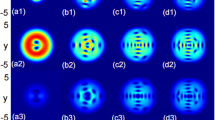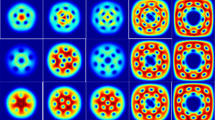Abstract
We investigate the vortex lattice configuration in a rotating spin orbit-coupled spin-2 Bose–Einstein condensate confined in a quasi-two-dimensional harmonic trap. By considering the interplay between rotation frequency, spin–orbit couplings, and interatomic interactions, we explore a variety of vortex lattice structures emerging as a ground state solution. Our study focuses on the combined effects of spin–orbit coupling and rotation, analyzed by using the variational method for the single-particle Hamiltonian. We observe that the interplay between rotation and Rashba spin–orbit coupling gives rise to different effective potentials for the bosons. Specifically, at higher rotation frequencies, isotropic spin–orbit coupling leads to an effective toroidal potential, while fully anisotropic spin–orbit coupling results in a symmetric double-well potential. To obtain these findings, we solve the five coupled Gross–Pitaevskii equations for the spin-2 BEC with spin–orbit coupling under rotation. Notably, we find that the antiferromagnetic, cyclic, and ferromagnetic phases exhibit similar behavior at higher rotation.







Similar content being viewed by others
References
Y.-J. Lin, K. Jiménez-García, I.B. Spielman, Nature 471, 83 (2011)
D.L. Campbell, R.M. Price, A. Putra, A. Valdés-Curiel, D. Trypogeorgos, I.B. Spielman, Nat. Commun. 7, 10897 (2016)
X. Luo, L. Wu, J. Chen, Q. Guan, K. Gao, Z.-F. Xu, L. You, R. Wang, Sci. Rep. 6, 18983 (2016)
Z.F. Xu, R. Lü, L. You, Phys. Rev. A 83, 053602 (2011)
T. Kawakami, T. Mizushima, K. Machida, Phys. Rev. A 84, 011607(R) (2011)
Z.F. Xu, Y. Kawaguchi, L. You, M. Ueda, Phys. Rev. A 86, 033628 (2012)
B.M. Anderson, I.B. Spielman, G. Juzeliūnas, Phys. Rev. Lett. 111, 125301 (2013)
Z.-F. Xu, L. You, M. Ueda, Phys. Rev. Rev. A 87, 063634 (2013)
X.-Q. Xu, J.H. Han, Phys. Rev. Lett. 107, 200401 (2011)
J. Radić, T.A. Sedrakyan, I.B. Spielman, V. Galitski, Phys. Rev. A. 84, 063604 (2011)
J. Radić, Spin–orbit-coupled quantum gases (2015) [Doctoral dissertation, Maryland University]
X.-F. Zhou, J. Zhou, C. Wu, Phys. Rev. A 84, 063624 (2011)
C.-F. Liu, H. Fan, Y.-C. Zhang, D.-S. Wang, W.-M. Liu, Phys. Rev. A 86, 053616 (2012)
A. Aftalion, P. Mason, Phys. Rev. A 88, 023610 (2013)
H. Wang, L. Wen, H. Yang, C. Shi, J. Li, J. Phys. B At. Mol. Opt. Phys. 50, 155301 (2017)
C. Shi, L. Wen, Q. Wang, H. Yang, H. Wang, J. Phys. Soc. Jpn. 87, 094003 (2018)
H. Yang, Q. Wang, N. Su, L. Wen, Eur. Phys. J. Plus 134, 589 (2019)
Q.-B. Wang, H. Yang, N. Su, L.-H. Wen, Chin. Phys. B 29, 116701 (2020)
J.-G. Wang, Y.-Q. Li, Results Phys. 17, 103099 (2020)
C.-F. Liu, Y.-M. Yu, S.-C. Gou, W.-M. Liu, Phys. Rev. A. 87, 063630 (2013)
Q. Zhao, H. Bi, Int. J. Theor. Phys. 60, 2778 (2021)
S.K. Adhikari, J. Phys. Condens. Matter 33, 065404 (2021)
P. Peng, G.-Q. Li, W.-L. Yang, Z.-Y. Yanga, Phys. Lett. A 382, 2493 (2018)
X.-F. Zhang, B. Li, S.-G. Zhang, Laser Phys. 23, 105501 (2013)
J. Li, X.-F. Zhang, W.-M. Liu, Ann. Phys. 87, 396 (2018)
P. Banger, R.K. Kumar, A. Roy, S. Gautam, J. Phys. Condens. Matter 35, 045401 (2023)
G.-P. Chen, P. Tu, C.-B. Qiao, J.-X. Zhu, Q. Jia, X.-F. Zhang, Front. Phys. 9, 613 (2021)
H. Zhu, C.-F. Liu, D.-S. Wang, S.-G. Yin, L. Zhuang, W.-M. Liu, Phys. Rev. A 104, 053325 (2021)
C.V. Ciobanu, S. Yip, T. Ho, Phys. Rev. A 61, 033607 (2000)
A. Widera, F. Gerbier, S. Fölling, T. Gericke, O. Tatjana, I. Bloch, New J. Phys. 8, 152 (2006)
Y. Kawaguchi, M. Ueda, Phys. Rep. 520, 253–381 (2012)
N. Goldman, G. Juzeliūnas, P. Öhberg, I.B. Spielman, Rep. Prog. Phys. 77, 126401 (2014)
I.E. Rashba, Y.A. Bychkov, J. Phys. C 17, 6039 (1984)
P. Kaur, A. Roy, S. Gautam, Comput. Phys. Commun. 259, 107671 (2021)
P. Banger, P. Kaur, S. Gautam, Int. J. Mod. Phys. C 33(4), 2250046 (2022)
R. Ravisankar, D. Vudragović, P. Muruganandam, A. Balaž, S.K. Adhikari, Comput. Phys. Commun. 259, 107657 (2021)
P. Muruganandam, A. Balaž, S.K. Adhikari, Comput. Phys. Commun. 264, 107926 (2021)
P. Banger, P. Kaur, A. Roy, S. Gautam, Comput. Phys. Commun. 279, 108442 (2022)
P. Kaur, S. Gautam, S.K. Adhikari, Phys. Rev. A 105, 023303 (2022)
A.L. Fetter, Rev. Mod. Phys. 81, 647 (2009)
Acknowledgements
I thank Sandeep Gautam for the fruitful discussions and comments on the manuscript.
Author information
Authors and Affiliations
Corresponding author
Additional information
Publisher's Note
Springer Nature remains neutral with regard to jurisdictional claims in published maps and institutional affiliations.
Appendix
Appendix
The single-particle Hamiltonian for case I is
Under a unitary transformation the \(H_{\textrm{rot}}\) can be diagonalised, which has the eigenvalues
The spectrum in Eqs. (18a)–(18b) around a minima can be described by a parabola of form \((k_x-k_{x\min })^2+(k_y-k_{y\mathrm min})^2+E_{\min }\), which describes the particle moving in an effective gauge field \((\textbf{A},\bar{\Phi })=(\{k_{x\min },k_{y\min },0\},E_{\min })\), where \(\textbf{A}\) and \(\bar{\Phi }\) are vector and scalar potentials, respectively [10, 11]. In the presence of rotation term \(k_{x\min }, k_{y\min }\) and \(E_{\min }\) become spatially dependent [10, 11]. Rewriting Eqs. (18a)–(18b) as
where \(\textbf{A}_{\pm 2} = \mp (2\gamma _x\pm y\Omega ,x\Omega ),\quad \textbf{A}_{\pm 1} = \mp (\gamma _x\pm y\Omega ,x\Omega ),\quad \textbf{A}_0 = (-y\Omega ,x\Omega )\), and \(\bar{\Phi }_j = E_j^{\min }\) with (\(j = 0,\pm 1,\pm 2\)). The effective potentials, which are the sums of trapping and scalar potentials [10, 11], can now be written as
From Eqs. (20a)–(20c), the effective potential curves correspond to \(V_{\textrm{eff}}^{\pm 2}\) are the lowest lying depending on the region.
Rights and permissions
Springer Nature or its licensor (e.g. a society or other partner) holds exclusive rights to this article under a publishing agreement with the author(s) or other rightsholder(s); author self-archiving of the accepted manuscript version of this article is solely governed by the terms of such publishing agreement and applicable law.
About this article
Cite this article
Banger, P. Vortex Lattice Formation in Spin–Orbit-Coupled Spin-2 Bose–Einstein Condensate Under Rotation. J Low Temp Phys 213, 155–170 (2023). https://doi.org/10.1007/s10909-023-03000-1
Received:
Accepted:
Published:
Issue Date:
DOI: https://doi.org/10.1007/s10909-023-03000-1




